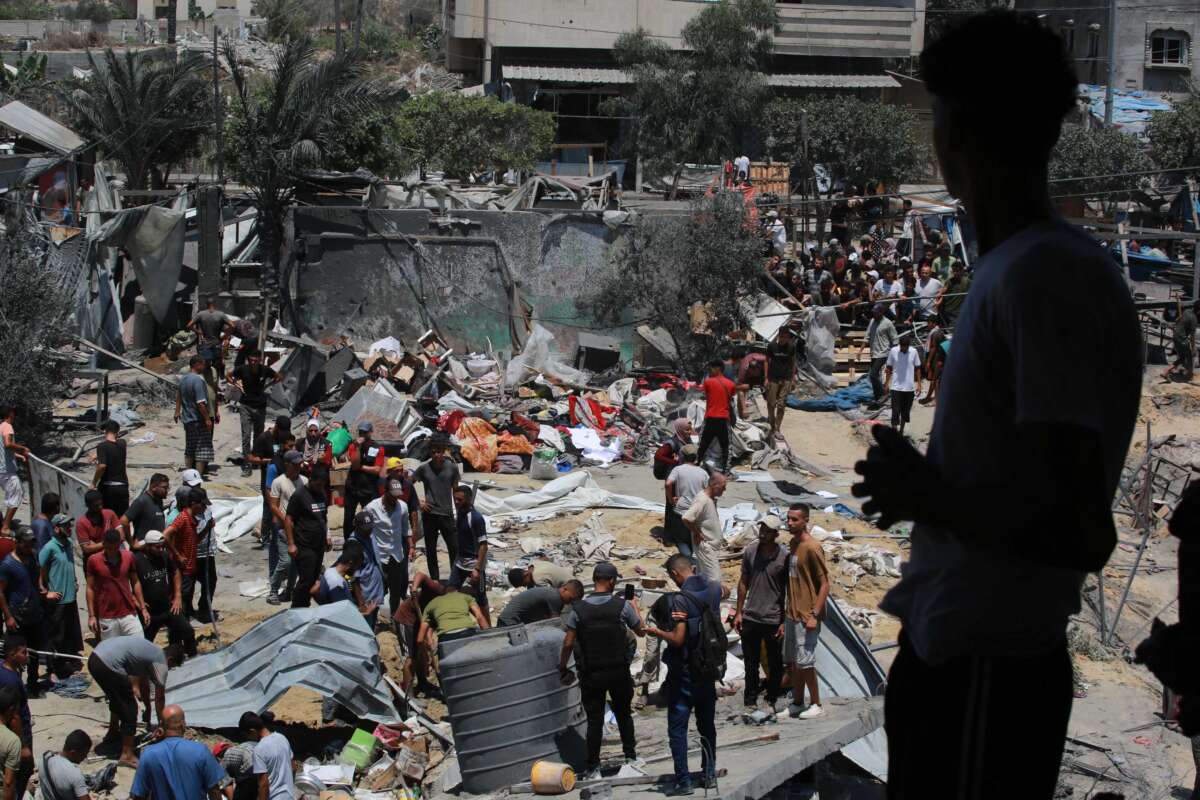Just over two months ago, Israel forced more than a million Palestinians who were taking shelter in southern Gaza to flee, once again, to an area it designated as a “humanitarian safe zone” — an area that the Israeli military has since attacked at least 10 times, new research finds.
According to London research group Forensic Architecture, the area in Al-Mawasi now sheltering thousands of Palestinians has been subject to Israeli attacks since May 6, when Israeli officials first delineated the “safe” zone.
The attacks started as early as two weeks after Israel forced Palestinians to flee to the area, a desert region with essentially no infrastructure, laying waste to tents and makeshift shelters set up to house people who Israel has displaced time and again in the past nine months.
“As with its relentless targeting of hospitals, Israel’s regular attacks on the so-called ‘humanitarian zone’ in al-Mawasi threaten to normalise such flagrant violations of international law,” Forensic Architecture wrote on social media. “The deadly strike on Saturday is just one in a series of repeated attacks on the designated humanitarian zone: we have mapped 10 attacks since 6 May.”
These findings contradict Israel’s claims that Al-Mawasi — and other supposed “safe zones” in Gaza — are exempt from the Israeli military’s campaign of “total annihilation.” They also demonstrate Israel’s strategy of forcing Palestinians into smaller and smaller areas in Gaza and then bombing those areas.
Israel’s attack on the Al-Mawasi “safe” zone on Saturday, in which the military dropped 8 2,000-pound bombs on a civilian area, killed at least 90 Palestinians and injured 300 more, officials reported. At least one of the bombs dropped was made in the U.S.
Those sheltering in the “safe” zone during the massacre included desperate families who had been forced to evacuate multiple times since October, and at least one survivor of the 1948 Nakba.
Survivors of the massacre describe scenes of horror as Israel’s shells rained down — children with severed limbs, people beheaded, and shrapnel, blood, and body parts flying everywhere.
Just days after, Israel unleashed another set of bombs on Al-Mawasi on Tuesday, killing at least 17 Palestinians.
At least two of these attacks on the “safe” zone have used U.S. bombs. An Israeli strike on May 26 that killed at least 45 people and injured 250 more used two Boeing-made bombs on a camp for displaced Palestinians.
These attacks on the explicitly designated “safe” zone come as Israel has relentlessly attacked other areas of Gaza in violation of international humanitarian law, which forbids targeting civilian infrastructure.
The UN reported on Wednesday, for instance, that it has recorded eight attacks on schools in Gaza in the past 10 days, including six UN schools. This includes an Israeli attack on a UN school in Nuseirat refugee camp on Tuesday, in which two Israeli strikes killed 20 people in the facility, now a shelter for displaced people.
The World Health Organization also reported that the Israeli military has attacked health care facilities in Gaza over 1,000 times since October — part of Israel’s systematic campaign to destroy all infrastructure essential to life in Gaza.
Trump is busy getting ready for Day One of his presidency – but so is Truthout.
Trump has made it no secret that he is planning a demolition-style attack on both specific communities and democracy as a whole, beginning on his first day in office. With over 25 executive orders and directives queued up for January 20, he’s promised to “launch the largest deportation program in American history,” roll back anti-discrimination protections for transgender students, and implement a “drill, drill, drill” approach to ramp up oil and gas extraction.
Organizations like Truthout are also being threatened by legislation like HR 9495, the “nonprofit killer bill” that would allow the Treasury Secretary to declare any nonprofit a “terrorist-supporting organization” and strip its tax-exempt status without due process. Progressive media like Truthout that has courageously focused on reporting on Israel’s genocide in Gaza are in the bill’s crosshairs.
As journalists, we have a responsibility to look at hard realities and communicate them to you. We hope that you, like us, can use this information to prepare for what’s to come.
And if you feel uncertain about what to do in the face of a second Trump administration, we invite you to be an indispensable part of Truthout’s preparations.
In addition to covering the widespread onslaught of draconian policy, we’re shoring up our resources for what might come next for progressive media: bad-faith lawsuits from far-right ghouls, legislation that seeks to strip us of our ability to receive tax-deductible donations, and further throttling of our reach on social media platforms owned by Trump’s sycophants.
We’re preparing right now for Trump’s Day One: building a brave coalition of movement media; reaching out to the activists, academics, and thinkers we trust to shine a light on the inner workings of authoritarianism; and planning to use journalism as a tool to equip movements to protect the people, lands, and principles most vulnerable to Trump’s destruction.
We urgently need your help to prepare. As you know, our December fundraiser is our most important of the year and will determine the scale of work we’ll be able to do in 2025. We’ve set two goals: to raise $150,000 in one-time donations and to add 1,500 new monthly donors.
Today, we’re asking all of our readers to start a monthly donation or make a one-time donation – as a commitment to stand with us on day one of Trump’s presidency, and every day after that, as we produce journalism that combats authoritarianism, censorship, injustice, and misinformation. You’re an essential part of our future – please join the movement by making a tax-deductible donation today.
If you have the means to make a substantial gift, please dig deep during this critical time!
With gratitude and resolve,
Maya, Negin, Saima, and Ziggy
